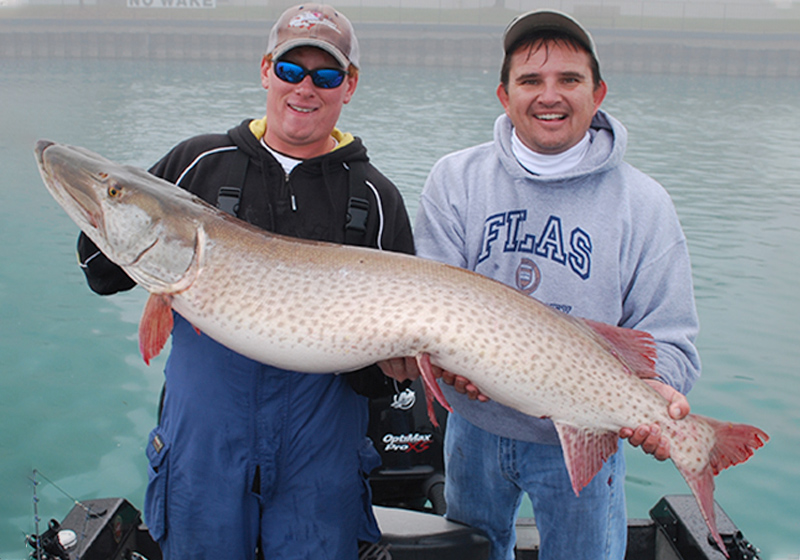Lake St. Clair Spotlight

In 2012 I wrote a two-part article about fishing in Lake St. Clair. The first part of the article laid out the history of the lake and how different environmental factors including invasive species, disease, and fishing pressure had sculpted and changed this amazing fishery over the last 40 years. That data translated to St. Clair having arguably the best musky population of any lake in the world when the articles were published in 2012. The second half of the article talked about fishing techniques including how the trolling bite had evolved overtime on this storied musky trolling lake. Additionally, the article talked about how the casting bite had just started to gain some popularity out in the open water. It went on to lay out the lakes incredible potential to casters and described the overall fantastic casting opportunity. That, however, was six years ago, and as we all know that is a long time for a lake to remain high on the musky fishing top hit list. This begs the question: How has the lake changed biologically and how has the fishing pressure affected the bite on the lake?
Biological Changes
Despite only six years passing between articles, Lake St. Clair has seen several major environmental changes take place. Some have had a dramatic effect on how the lake fishes and others have caused little change. The first major change to the fishery was the water level. In 2012 the deepest natural (not including the dredged channel) part of the lake was just less than twenty feet of water. At that point, the Great Lakes were overall at an all-time low. Since St. Clair is part of the Great Lakes, it is no surprise that it also was at an extremely low level. Today we see a different story with the Great Lakes at close to an all-time high. Currently, St. Clair is at the second-highest levels in history. Additionally, all indicators show the Great Lakes going up more in upcoming years, however, that is only speculation. Right now the deepest part of the lake is just over twenty-four feet. Although four feet doesn’t sound like a lot, consider that the average depth of the lake was around eleven feet and is now over fifteen feet. This is more than a 36% increase in the overall water depth and therefore water volume. Despite this rise, the lake still remains roughly the same size as far as surface acres are concerned coming in around 274,000 acres. One major change that the higher water levels have had is an increase in the current traveling through the system. Both the St. Clair River and the Detroit River have seen current speed pick up with the average current increasing more than one mile per hour each. Although the lakes current speed varies depending on your proximity to the channel we have seen a massive increase in the lakes overall current speed. This has ultimately led to some dramatic changes in the movements of the fish, particularly in the mid-summer period when the fish are strongly relating to current based areas.
Another biological factor that hit St. Clair in the spring of 2017 was a breakout of VHS virus. As many remember this virus hit the lake in the early 2000’s with a musky mortality rate of 30-40%. Although at the time the die-off seemed horrific the kill ended up strengthening the musky genetics of the lake and therefore helped dramatically, despite temporarily lowering numbers. This recent kill, however, was nowhere near as deadly. Although it got a lot of play on social media the actual numbers are speculated to be extremely low. Neither the DNR nor MNR conducted any research on the most recent kill however most guides agree that we saw less than a 5% kill with many, including myself, feeling that the 5% number could be high. Either way, the mortality rate of this outbreak was barely worse than standard winterkill having little to no long-term effect on the musky population.
Fishing 2018 Lake St. Clair Muskies
These biological changes to the lake have all had an impact on different aspects of the lake. Some have made little to no change in the musky fishing and others have resulted in huge changes. The biggest biological change that impacted the musky fishing on the lake is the increase in water levels. The first major impact these higher water levels have had on Lake St. Clair is cleaner water. After the introduction of mussels to the St. Clair system in the mid-1990’s the water on the lake has been on average very clear. The majority of the lakes stained water now comes from the combination of wave action on a mostly hard bottom. On windy days this wave action roles over the water column causing lose sediment on the bottom to get rolled into the water. This is what gives much of the lake its greenish or teal colored tint depending on bottom content. However, the increase in water levels has made this much more challenging. In the past when the lakes average depth was eleven foot it only took 2-2.5 foot waves to roll the water column over and create that desired 3-4 foot green watercolor that muskies and shad seem to love. Now, with the depth average being closer to fifteen-foot, it takes much more substantial wave action to role the water column over. This has made the lake much clearer on average. The next major change the lake has seen was the decrease in water temperatures. With the water levels going up more than 35% we have also seen the average summer water temperature of the lake fall considerably. This decrease in temperature is due to both the increase in the lake's volume, caused by the deeper water, as well as the clearer water-attracting less of the suns UV rays.
These changes have not necessarily caused a decrease in the musky fishing like one might suspect. They have, however, caused the movements of the fish to change over the years. The learning curve involved with these changes has caused many fishermen to struggle at times, as spots that held fish in previous years have gone dry. There is always a learning curve involved in finding the fishes new hunts after the trusted ones go dry.
The first major change we have seen in musky habits is the movement of more and more fish to the east end of the lake. Although you can always find fish all over in such a vast lake, we have definitely seen a shift of both bait and muskies to the East and Southeast side of the lake. The reasoning behind this is twofold; first the east end of the lake tends to have darker water due to its harder bottom and less weed growth. Also, the east end of the lake gets most of its water from the Thames River which tends to be darker stained water rather than the rest of the lake whose water comes from Lake Huron which is almost always extremely clear. This more stained water is perfect for filter feeders such as shad which are muskies main forage. The stained water is located on the South East end of the lake which is as far from the cold inflowing water from Lake Huron. This results in these areas heating up quicker in the spring and attracting fish. The result is many muskies migrating in this direction in the spring to spawn. Since this area contains everything a musky needs to live, combined with the fact that it rarely gets too warm in the middle of summer, it results in many of these fish staying in the east end all year.
The other major shift in the musky movements on Lake St. Clair is located in the area known as “the middle.” The middle area of the lake also referred to as the weather buoy area, used to be “the place” to fish in July and August. This center section receives a ton of current flow from Lake Huron whose water is dramatically cooler than St. Clair’s in the summer months. In mid-summer the perimeter of St. Clair previously would get too hot for shad and muskies to live comfortably. This caused the fish to migrate to the center of the lake where the current flow would cause the water temperatures to be dramatically cooler. However, with the increase in water levels, we seldom see the perimeter of the lake getting warm enough to drive muskies to the center in the same numbers as in the lower water period. Although we do see plenty of fish in the middle in July and August, it definitely isn’t the only place to get bites in the mid summer with most anglers still finding plenty of fish on the south shore.
One very exciting biological impact we are seeing right now are the benefits of the mid 2000’s VHS outbreak. As with any virus, VHS mainly affects the young and the old in a population due to there lower immune systems. Given the time frames with VHS hitting the lake worst in 2005-2006 and the muskies growth rates on St. Clair averaging roughly 12-13 years for a fish to hit 50 inches, we now see the number of 50-52 inchers significantly lower then normal. However the year classes of fish after VHS are some of the strongest the lake has ever seen and starting in 2018 these fish should achieve 50 inches. In 2017 nearly every guide on the lake saw a HUGE number of fish in the 48-49.5 inch class. This means the number of 50 inchers for the 2018 season should be tremendously high with 2019 expected to set records for 50+ inch fish.
Trolling
Over the past six years the trolling bite on Lake St. Clair has not seen a ton of changes compared to the casting bite. Despite this there have still been several tweaks that we have seen top captains do to adjust to the lakes new conditions. First the colder lake temperatures tend to lean slightly toward slower trolling speeds. Whereas 5 mph was the standard in the early 2000’s, and 4.2 mph in 2012, now most top trolling charters would agree that 3.7-4 mph is the most common for big fish fisherman. Also, due to the increase in water clarity most trollers have noticed less bites coming on rods run straight behind the boat with the board rods set away from the boat far out producing. This change is assumed to be due to the spookier nature of muskies in clearer water. Another major change we have seen in St. Clair musky trolling is a change in lure selection. Top Lake St. Clair trolling Captain Jason Quintano says “today the cooler lake temperatures combined with the musky crankbait evolution has definitely had an impact on our selection. In the summertime, our crankbaits selection used to consist of almost all 6-inch crankbaits due to their super erratic nature. Now with the invention of such lures as the headlock and matlock we are using 10 and 12 inch baits all summer long with great success. These baits have the same erratic motion in the water as the smaller lures which was something we hadn’t seen before.” Another major change Captain Quintano pointed out was the shift in trolling bucktail colors from mostly solid colors to a variety of color combinations. He states “a few years ago you only really needed to run lavender and Hulk Hogan (a light chartreuse color) colored bucktails, today we see all different colors going at certain times and in certain conditions. Now you must have a large variety of colors to adjust to the water conditions and fish preferences for that day.” For bucktail selection double 10’s still seem to get the nod with Musky Mayhem trolling girls being a top choice.
Casting
In 2010-2012 the casting bite on the lake was very much untapped. I would go weeks and even sometimes months on the water without seeing another caster. Today those days are pretty much over. Despite this, the lakes overall size and the incredibly high number of muskies virtually ensure that the increased pressure won’t serve to overpressure or over educate the fish. The one major impact this increase in pressure has had on the casting bite is the dramatic increase in figure-eight bites. Today we see 20-40% of your strikes coming on figure eight verses 2012 when it was virtually unheard-of.
When it comes to casting lures on St. Clair we still see rubber baits such as Bulldawgs and Medusas having a stranglehold on the lake. Other baits, such as bucktails and paddle tail swimbaits, have seen the casting numbers fall off slightly as the pressure increases; however, the bulldawgs and medusa still see extremely high success rates. One change, however, is in the color of the baits that seem to be working. With the water clarity clearing up we have seen colors such as black and orange and ball licker (not sure if you want to swap that out for black orange with a white belly, I will leave it to you Steve) take a back seat to more natural colors such as walleye, sucker and cisco.
Although Lake St. Clair has seen some good and some bad changes in the last several years, its fishing is still some of the best in the world. In 2017 my boat saw just under 600 muskies with nearly 40 over 50 inches and 6 over 54. Although these numbers are down from previous years it is still some of the best musky fishing out there. With the great year classes of 50 plus inch fish coming up combined with a better understanding of the lake in higher water conditions we hope to have many record years ahead of us. If you are looking for a fishing destination this upcoming season make sure Lake St. Clair is on the top of your list!
HOURS
Monday
7:00am - 8:00pm
Tuesday
7:00am - 8:00pm
Wednesday
7:00am - 8:00pm
Thursday
7:00am - 8:00pm
Friday
7:00am - 8:00pm
Sat. & Sun.
7:00am - 8:00pm
Spencer's Angling Adventures
29474 Old North River Road
Harrison Township, MI 48045
(419) 410-0498


